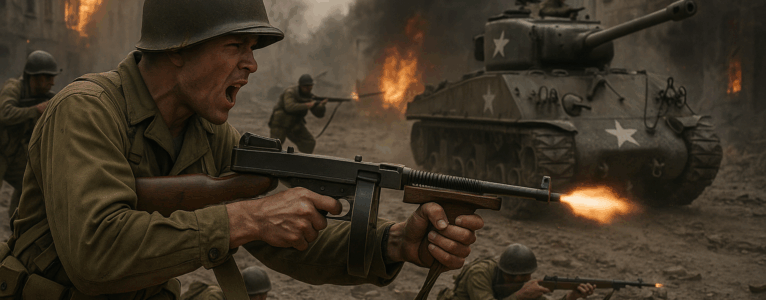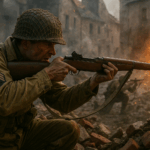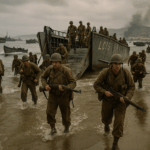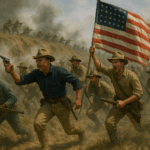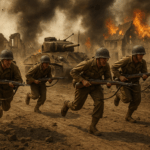If you’ve read any of my books, you’ve probably noticed the Thompson submachine gun shows up more than a few times. Whether it’s in the hands of a World War II paratrooper, a gritty resistance fighter, or a hardened Ranger, the “Tommy Gun” has become a recurring presence in my stories—for good reason. Its iconic design, raw stopping power, and dramatic history make it more than just a weapon; it’s a character in its own right.
In this post, I want to dive a little deeper into the real-world history behind the Thompson. From its notorious reputation in the gangster era to its widespread use across every theater of World War II, the Thompson has left a lasting legacy that deserves a closer look. Whether you’re a fellow history buff, a fan of military fiction, or just curious about the gun behind the legend, here’s everything you need to know.
Few weapons in modern history have straddled the line between infamy and honor quite like the Thompson submachine gun. Better known by its nickname, the “Tommy Gun,” this .45-caliber icon became synonymous with American firepower—first on the streets of Chicago during the lawless years of Prohibition, and later across the battlefields of World War II.
Its distinctive silhouette, drum magazine, and brutal stopping power made it a favorite of gangsters, federal agents, and front-line soldiers alike. But the story of the Thompson is more than just cinematic nostalgia—it’s a tale of innovation, missteps, reinvention, and global impact.
A Gun Without a War
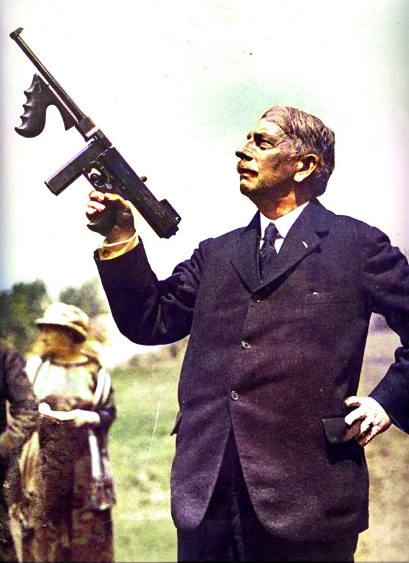
The Thompson’s story begins not in a back alley or a battlefield, but in the closing days of World War I. Brigadier General John T. Thompson, a veteran of the Ordnance Department, believed that infantry needed a weapon capable of high-volume fire in the close quarters of trench warfare—a “trench broom,” as he called it.
Together with investors and engineers, he formed the Auto-Ordnance Corporation in 1916. With backing from the wealthy Thomas Fortune Ryan and technical input from engineers like Theodore Eickhoff and Oscar Payne, Thompson set out to develop a compact automatic weapon that could be fired from the hip and operated by a single soldier.
Central to the design was the “Blish lock,” a theoretical delayed-blowback system developed by naval officer John Blish. Though later proven to be unnecessary, it helped shape the initial prototypes. The resulting weapon, dubbed the “Annihilator,” was completed just as World War I came to an end. With no battlefield to prove itself on, the gun needed a new purpose—and it found one on the streets of Prohibition-era America.
Chicago Typewriters and Hollywood Legends
With the United States plunged into the chaos of Prohibition in the 1920s, organized crime exploded—and so did the demand for firepower. The Thompson, with its high rate of fire and intimidating appearance, was quickly adopted by gangsters like Al Capone’s outfit in Chicago, and used in infamous events like the St. Valentine’s Day Massacre in 1929.
Ironically, the very law enforcement agencies tasked with stopping these criminals also adopted the weapon—if only to level the playing field. FBI agents and police departments began purchasing Thompsons to counter heavily armed criminals. This dual identity—hero and villain—only added to its mystique.
Hollywood noticed. Films like Little Caesar (1931), Scarface (1932), and dozens of B-movie crime dramas gave the Tommy Gun a starring role. Its menacing shape, with a round drum magazine and vertical foregrip, was instantly recognizable. The Thompson didn’t just fire bullets—it fired the imagination.
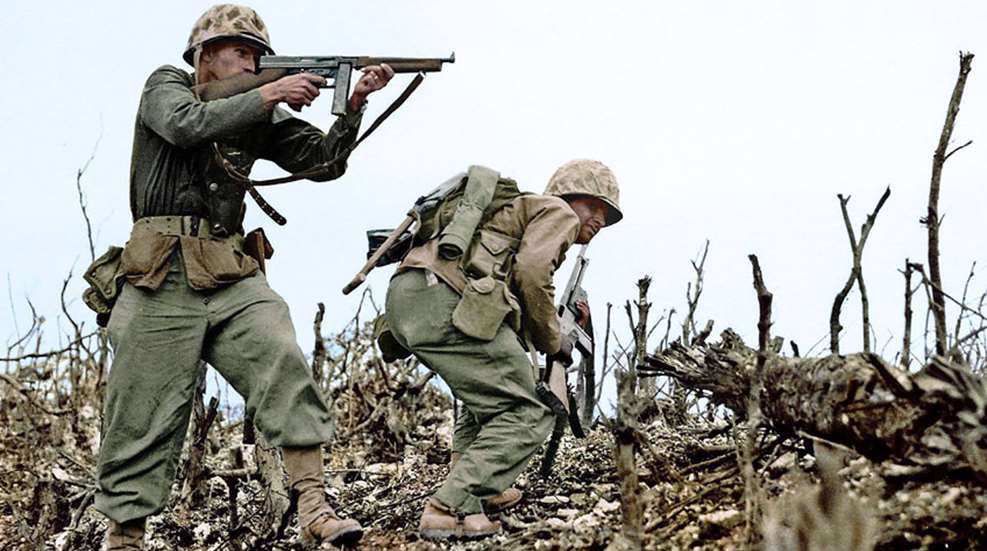
“A one-man, hand-held machine gun. A trench broom.”
— Brig. Gen. John T. Thompson, envisioning his submachine gun in 1917
From Armories to Armies: A Second Chance in World War II
While the Thompson’s image was cemented in the public consciousness, it remained a commercial failure for much of the 1920s and ’30s. Only 15,000 Model 1921s were produced by Colt under contract, and sales were sluggish. Most went to law enforcement or were kept in storage.
Everything changed with the outbreak of World War II.
As the United States rearmed following the attack on Pearl Harbor, there was an urgent need for reliable, powerful infantry weapons. The Thompson was one of the few automatic weapons already in production, and despite earlier hesitation, the U.S. military began placing massive orders.
The M1928A1 variant, fitted with a Cutts compensator, finned barrel, and drum or stick magazines, was quickly issued to Marines, paratroopers, Rangers, and armored vehicle crews. British forces received thousands via Lend-Lease and adopted it for commandos and special operations units. Commonwealth troops in Canada, Australia, India, and New Zealand also took the weapon into the field.
Thompsons fought in every theater—jungle warfare in the Pacific, city fighting in Europe, and even the deserts of North Africa. Soldiers respected its devastating firepower, especially in close quarters. One burst of .45-caliber rounds could clear a room or trench. While heavy, and sometimes unreliable in sandy or wet conditions, the gun was generally loved by those who used it.
Making It War-Ready: Simplification and the M1 Series
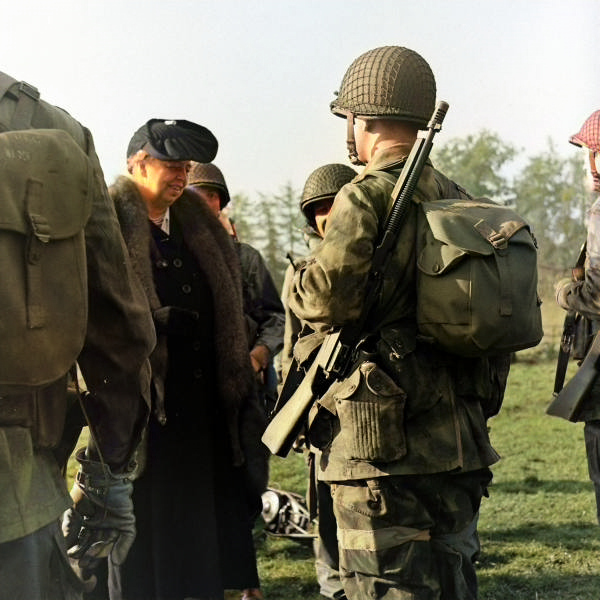
Though effective, early Thompsons were expensive and complex. The M1928A1, with its high machining requirements and blued finish, cost over $200 to manufacture—more than twice the cost of an M1 Garand rifle.
In response, Auto-Ordnance and Savage Arms simplified the design. They eliminated the Blish lock, switched to a straight blowback system, and simplified the receiver. The result was the M1 Thompson, followed soon after by the even more efficient M1A1, which featured a fixed firing pin.
These wartime models ditched the iconic drum magazine—too bulky and noisy in the field—in favor of 20- and 30-round stick magazines. The beautiful walnut wood was often replaced with cheaper hardwoods or even plastics. Muzzle compensators were removed. Function triumphed over form.
Yet despite the cost-saving changes, the essence of the weapon remained: brutal close-range firepower in a package infantry could carry into battle.
By the end of the war, over 1.5 million Thompsons had been produced.
The Thompson’s Global Footprint
While American GIs and Marines carried Thompsons into battle, so did soldiers from across the globe. British commandos wielded them during raids in occupied France. French resistance fighters used them to sabotage German supply lines. Soviet troops, supplied with Thompsons via Lend-Lease, brought them into action on the Eastern Front.
Even after the war, the Thompson continued to see combat: in Korea, Vietnam (early on), and in conflicts across Africa and Latin America. Its simplicity and power ensured its survival well into the Cold War era, long after more modern submachine guns had entered service.
The Legend Lives On
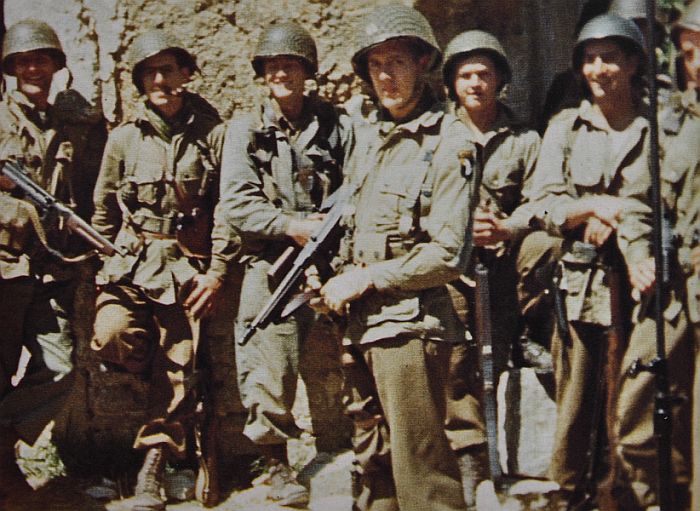
Today, the Thompson submachine gun holds a unique place in history. It’s a collector’s item, a museum piece, and a pop culture icon. Its unmistakable silhouette still appears in films, video games, and reenactments. For gun enthusiasts, it remains one of the most sought-after historic firearms.
But beyond the movies and memorabilia, the Tommy Gun tells a very real story about how military needs, engineering innovation, and cultural perception collide. It’s a story that begins in the mud of the trenches and ends in the global theaters of World War II.
From bootleggers to beachheads, the Thompson earned its reputation—not just through what it could do, but through what it symbolized: raw power, American ingenuity, and the fine line between chaos and control.

